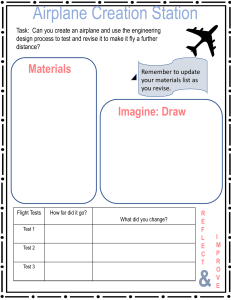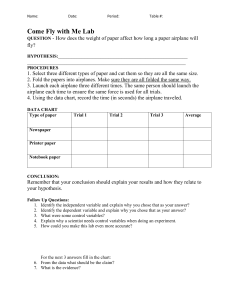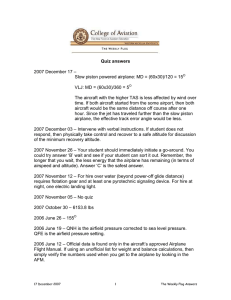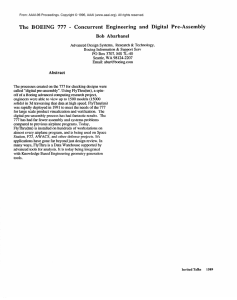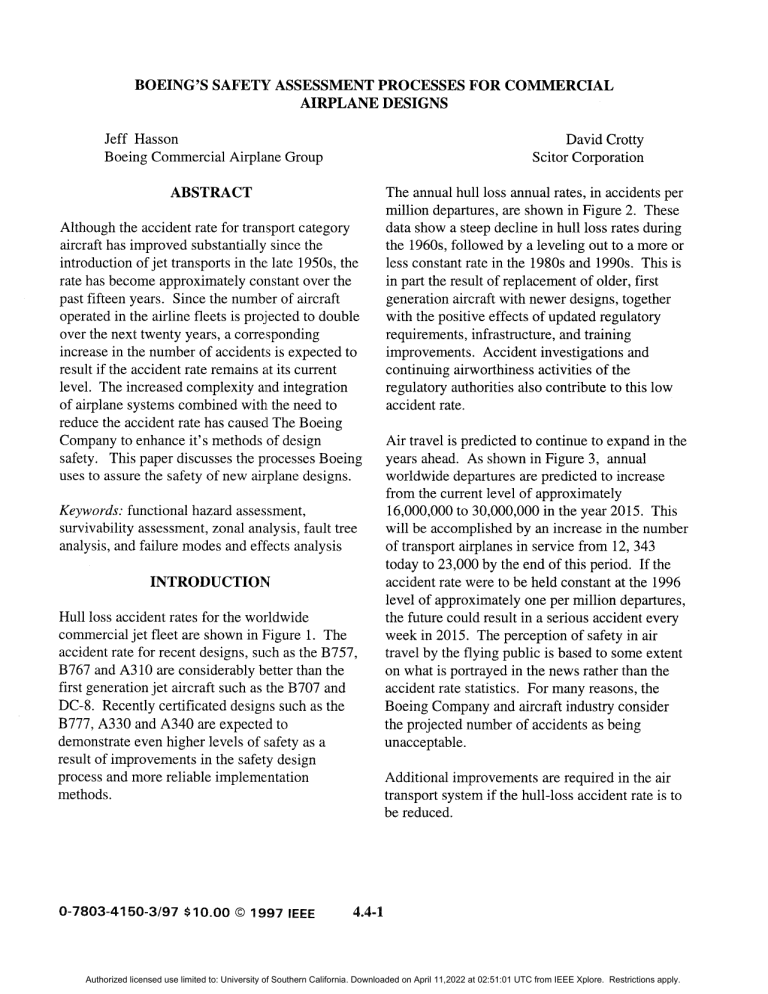
BOEING’S SAFETY ASSESSMENT PROCESSES FOR COMMERCIAL AIRPLANE DESIGNS Jeff Hasson Boeing Commercial Airplane Group David Crotty Scitor Corporation ABSTRACT Although the accident rate for transport category aircraft has improved substantially since the introduction of jet transports in the: late 1 9 5 0 the ~~ rate has become approximately constant over the past fifteen years. Since the number of aircraft operated in the airline fleets is projected to double over the next twenty years, a corresponding increase in the number of accident,s is expected to result if the accident rate remains at its current level. The increased complexity and integration of airplane systems combined with the need to reduce the accident rate has caused The Boeing Company to enhance it’s methods of design safety. This paper discusses the processes Boeing uses to assure the safety of new airplane designs. Keywords: functional hazard assessment, survivability assessment, zonal analysis, fault tree analysis, and failure modes and effects analysis INTRODUCTION Hull loss accident rates for the worldwide commercial jet fleet are shown in Figure 1. The accident rate for recent designs, such as the B757, B767 and A3 10 are considerably better than the first generation jet aircraft such as the B707 and DC-8. Recently certificated designs such as the B777, A330 and A340 are expected to demonstrate even higher levels of safety as a result of improvements in the safety design process and more reliable implementation methods. 0-7803-41 50-3/97$10.00 0 I997 IEEE The annual hull loss annual rates, in accidents per million departures, are shown in Figure 2. These data show a steep decline in hull loss rates during the 1960s, followed by a leveling out to a more or less constant rate in the 1980s and 1990s. This is in part the result of replacement of older, first generation aircraft with newer designs, together with the positive effects of updated regulatory requirements, infrastructure, and training improvements. Accident investigations and continuing airworthiness activities of the regulatory authorities also contribute to this low accident rate. Air travel is predicted to continue to expand in the years ahead. As shown in Figure 3, annual worldwide departures are predicted to increase from the current level of approximately 16,000,000 to 30,000,000 in the year 2015. This will be accomplished by an increase in the number of transport airplanes in service from 12,343 today to 23,000 by the end of this period. If the accident rate were to be held constant at the 1996 level of approximately one per million departures, the future could result in a serious accident every week in 2015. The perception of safety in air travel by the flying public is based to some extent on what is portrayed in the news rather than the accident rate statistics. For many reasons, the Boeing Company and aircraft industry consider the projected number of accidents as being unacceptable. Additional improvements are required in the air transport system if the hull-loss accident rate is to be reduced. 4.4-1 Authorized licensed use limited to: University of Southern California. Downloaded on April 11,2022 at 02:51:01 UTC from IEEE Xplore. Restrictions apply. Figure 1. Hull Loss Accident Rates Worldwide Commercial Jet Fleet - 1959 through 1996 Trident vc-10 5AClll 2 21 737-112 55 BAe146 A300-600 737131415 F-100/70 A32OlA321 747-4w 2 2 9 8 2 4 1 1 0 Accidents per million departures Statistical accidents only. *<100,000 departures Figure 2. Hull Loss Accidents All Aircraft: Worldwide Commercial Jet Fleet 30 T 25 Not included: Sabotage Military action Commonweath of independent States aircraft Annual rates, accidents per million departures 60 62 64 66 68 70 72 74 76 78 80 Year 82 84 86 88 90 92 94 96 4.4-2 Authorized licensed use limited to: University of Southern California. Downloaded on April 11,2022 at 02:51:01 UTC from IEEE Xplore. Restrictions apply. Figure 3. We Need to Continuously Improve Aviation Safety “V 45 - Improvementareas: Lessons learned Airplanes in service W I # 40 35 - * Maintenance 0 Air traffic management Infrastructure 30 Hull loss accidents 25 20 15105- 0-1 1965 1975 1985 1995 2005 201 5 Year There are many areas which offer potential reductions to the accident rate. These improvement areas are: lessons learned, regulations, airplane designs, flight operations, maintenance, air traffic management, and infrastructure. Airplane systems have been implicated in a small percentage of the already low accident rate. New technologies provide an opportunity for enhancing safety, but also require rigorous and detailed methodologies to assure the design safety. This paper will discuss the processes that Boeing uses to assure the integrity of our airplane designs, which will contribute to a lower accident rate in the future. DISCUSSION - COMPLEXITY AND INTEGRATION The general increase in airplane functionality, complexity, integration, and technology requires new methods of safety assessment, implementation, and verification. First generation jet transport airplanes, such as the 707 and 727 were designed with relatively simple and independent systems. The monitoring and management of these systems to support the airplane functions were handled by the flight engineer. Advances in technology and improved system integration ultimately led to the elimination of the need for the flight engineer on the next generation of airplanes. The 757/767 airplanes introduced the use of digital implementations on Boeing models. Moderate system integration was required on these airplanes. To achieve increased functionality and performance, the 777 system architectures relied heavily on the use of microprocessors. The 777 systems are even more highly integrated than previous models. One aspect of this integration is 4.4-3 Authorized licensed use limited to: University of Southern California. Downloaded on April 11,2022 at 02:51:01 UTC from IEEE Xplore. Restrictions apply. increased use of common resources which dictates the sensor configurations and communication infrastructure. The digital fly-by-wire technology also required more extensive integration of the systems than on previous airplane designs at Boeing. Functional Safety Assessments This increase in functionality, complexity, integration, and technology required Boeing and the aircraft industry to rethink methods to show compliance with the applicable safety requirements. Several industry teams were established to address the issues related to this subject: (1) An Aviation Rulemaking Advisory Committee (ARAC) Harmonization Working Group to rewrite the FANJAA rule and advisory material for 25.1309 that establishes many of the safety requirements; (2) Two Society of Automotive Engineers (SAE) committees to develop aerospace recommended practices (ARPs) to document the processes. These two documents are ARP 4754 "Certification Considerations for Highly Integrated or Complex Aircraft Systems" and ARP 476 1 "Guidelines and Methods for Conducting the Safety Assessment Process on Civil Airborne Systems"; and (3) At least two Radio Technical Commission for Aeronautics (RTCA) committees to address related software and hardware aspects of these designs. Functional Safety Requirements. The functional safety requirements are derived from airplane and system functions. At the airplane level, this activity begins by identifying the airplane level functions required for safe flight and landing (e.g. pitch, roll, yaw, thrust, etc.). For each function, a Functional Hazard Assessment (FHA) is performed to identify potential failure conditions. The assessment includes considerations for environmental conditions and flight phase. Each identified failure condition is then classified based on the severity the hazard imposes on the aircraft, crew, and occupants. The hazard severity classifications are: catastrophic, hazardous, major, and minor. Allowable probabilities are assigned to each failure condition based on its classification level. The hazard classifications and corresponding probabilities are defined in the advisory material of FAWJAR 25.1309. The types of functional requirements that usually come from this safety assessment are availability (e.g. Loss of function) and integrity (e.g. Malfunction). AIRPLANE SAFETY ASSESSMENTS Boeing conducts safety assessments in three general areas: functional, physical, and operational. The assessments evaluate the airplane and crews' ability for continued safe flight and landing. The methods and tools for establishing requirements, developing the design, and performing the verification are different in each assessment area. Functional safety assessments address how well systems and equipment perform given functions. These assessments focus on the functional architectures. The FHA process is then repeated at the system level. A system can be categorized as either a primary or a supporting system. A primary system is one that directly performs an airplane function (e.g. flight control system, brake system, high-lift system, etc.). The primary system FHA is a subset of the airplane FHA and is easily traceable to the airplane FHA. A supporting system is one that does not directly perform an airplane function but usually supports multiple primary systems (e.g. electrical system, hydraulic system, air data system, etc.). For this reason, the supporting system FHA resembles a FMEA with the effects being at the airplane functions. The results of the system functional hazard 4.4-4 Authorized licensed use limited to: University of Southern California. Downloaded on April 11,2022 at 02:51:01 UTC from IEEE Xplore. Restrictions apply. assessments provide the basis for system functional safety requirements. Functional Desim. The designers propose airplane and system functional architectures that meet the overall objectives for a given function and also reduce or eliminate the hazards associated with these functions. The requirements and design are further developed for each subsequent layer of the design while keeping the FHA safety requirements in mind. For availability of critical functions, the design may take the form of a dual redundant primary system which is backed up by a dissimilar standby system. For integrity of critical functions, systems may vote multiple sources and/or employ an independent monitor. Functional Verification. The verification of functional designs usually takes the form of numerical analyses. A top-down evaluation of the more significant failure conditions is performed using Fault Tree Analyses (FTAs). In addition, a bottom-up review is performed for the major systems using Failure Modes and Effects Analyses (FMEAs). By combining the failure rates and exposure times into the fault tree we show the quantitative requirements are satisfjed. The two types of analyses (FTA and FMEA) also provide a cross-check that the proper item failures have been addressed. Physical Safety Assessments Physical safety assessments address how systems and equipment are installed on the aircraft. These assessments focus on the physical layout and configuration of the airplane. They are necessary to validate the redundancy and independence assumptions made in the functional assessments. Physical Safety Requirements. The physical safety requirements are derived from the physical threats to the airplane and systems. The thireats fall into two basic areas: threats originating from outside the system, called particular threats (such as: engine burst, birdstrike, tire burst, high intensity radiated fields, lightning, etc.) and threats originating within the system, called installation threats (such as: wire chafing and cross connection). The particular threat requirements are developed by reviewing the FARs/JARs and in-service events. A list of threats is gathered and a damage model is generated for each threat. The physical threats and associated damage profiles are levied as requirements to the airplane. The general safety objective is that no single threat or event shall result in a catastrophic failure condition. The installation threats are generated by reviewing in-service experience. These threats are continuously evolving based on decades of inservice experience. We use these threats to generate a set of design guidelines. The guidelines define separation and orientation requirements between the various transmission methods (e.g. electrical wiring, fuel lines, flight control cables, hydraulic line, oxygen lines, pneumatics ducts, torque tubes, etc.). Physical Design. Integrated product teams are used to develop the physical design implementation for each section of the airplane. Using the established safety requirements and design guidelines, the designers within these teams determine the best layouts with respect to producibility, maintainability, and safety. Physical Verification. The physical verification is performed throughout the design process. The particular threats that result in physical damage are addressed early in the design process as the major transmission raceways for wiring, hydraulic lines, etc. and equipment locations are defined. This is done through a series of survivability reviews. The survivabilty review 4.4-5 Authorized licensed use limited to: University of Southern California. Downloaded on April 11,2022 at 02:51:01 UTC from IEEE Xplore. Restrictions apply. team evaluates each major section of the airplane and verifies that the threats that apply to that section are survivable. Staged zonal reviews are performed as the physical design matures. Before releasing the drawings, 3-dimensional “fly-throughs” are performed to verify adequate clearances exist between transmission media. As systems are installed in the factory, engineering safety reviews are performed to verify proper installations. Reviews of high vibration areas are also performed following flight testing. For the physical threats that are not as installation dependent (e.g. high intensity radiated fields and lightning) individual studies and reviews are performed to verify that the requirements are satisfied. Operational Safety Assessments Operational Design Verification. During the development phase the operational scenarios are evaluated to determine the effect on the airplane and occupants. If the effects are not satisfactory, changes are incorporated into the design. In addition to the operational analysis described above, Boeing performs a series of evaluations on the flight crew and airplane interface. Early in the development an engineering mock up of the cockpit, called a Cab, is used to evaluate crew interfaces. In the case of the 777, this concept was greatly expanded to a systems integration lab which was also used to integrate the airplane systems. Using simulated inputs into the systems we could fly the airplane and test various failure scenarios. A full motion multi-purpose Cab is used to evaluate handling qualities under various scenarios. The final evaluation is performed during flight test when the airplane, systems, and procedures are thoroughly checked. Experience has shown us that unusual operational scenarios can lead to accidents. To address this concern Boeing dedicates a team of engineers to perform an operational safety assessment. Operational Safety Requirements. In the early development phase of a program, a team of engineers and pilots is established to develop a set of various operational scenarios. These scenarios may include: flight in volcanic ash, engine out scenarios, and return to land scenarios. From these scenarios and subsequent analysis the airplane operational safety requirements are established. Operational Design. Each developmental program has a dedicated group of pilots and flight deck engineers to analyze the airplane-to-crew interface design and procedures. This group works with the system designers to develop the proper crew alerts and procedures. The activity includes both the normal and non-normal procedures. SUMMARY Given the current accident rate and the projected increase in departures one could anticipate a serious accident once a week by the year 2015. Increased functionality and performance has required airplane designs to become more complex and integrated. While safety considerations have always been paramount, the above two considerations have caused the industry and The Boeing Company to focus on further safety improvements throughout the design process. The safety processes can be viewed from three perspectives: functional, phjsicul, and uperutional. Each view has different methods for developing safety requirements and performing safety a.ssessments. 4.4-6 Authorized licensed use limited to: University of Southern California. Downloaded on April 11,2022 at 02:51:01 UTC from IEEE Xplore. Restrictions apply. The functional view uses functional hazard assessments to derive the high-level availability and integrity safety requirements. ‘These requirements are allocated to the systems and equipment that perform the function. Fault Tree Analyses are used to combine failure events and verify that the high-level requirements are satisfied. Failure Modes and Effects Analyses are used to understand the failure modes of the equipment and associated failure rates. The physical assessment uses threat lists and definitions to derive the survivability requirements. These requirements ,are allocated in the form of structure and system separation. Different zonal analyses are used to verify that these requirements are satisfied. Survivability reviews are used in the early design phases to examine major raceways and equipment installations. As the physical design matures 3dimensional “fly-throughs” are performed. The final reviews are conducted on the completed product in the factory and following flight testing. The operational assessment utilizes a set of operational scenarios developed from unusual inservice events. Each scenario is evaluated to determine the effect on the airplane design and performance. Unsatisfactory results are fed back into the design process. 4.4-7 Authorized licensed use limited to: University of Southern California. Downloaded on April 11,2022 at 02:51:01 UTC from IEEE Xplore. Restrictions apply.
